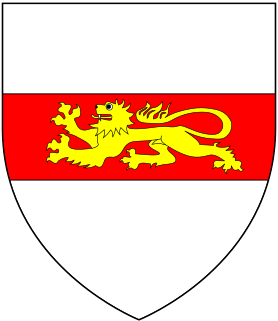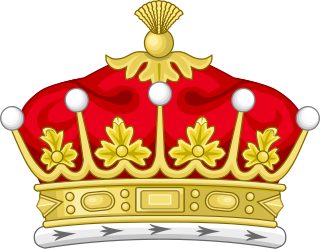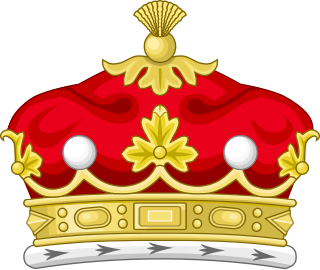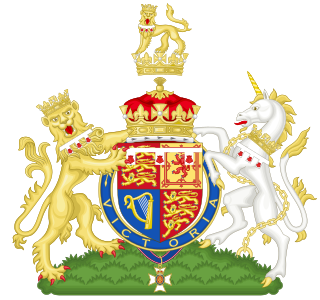 W
WBaron Alvanley, of Alvanley in the County Palatine of Chester, was a title in the Peerage of the United Kingdom. It was created on 22 May 1801 for Sir Richard Arden, the Chief Justice of the Common Pleas and former Master of the Rolls. The title became extinct on the death of his second son, the third Baron, in 1857.
 W
WBaron Arklow was a title in the Peerage of the United Kingdom that has been created twice. Arklow is a town in County Wicklow in Ireland.
 W
WDuke of Cambridge, one of the eight current royal dukedoms in the United Kingdom as of 2021, is a hereditary title of specific rank of nobility in the British royal family. The title is heritable by male descendants by primogeniture, and has been conferred upon members of the British royal family several times. The wife of the titleholder bears the title Duchess of Cambridge.
 W
WEarl of Carysfort was a title in the Peerage of Ireland. It was created in 1789 for John Proby, 2nd Baron Carysfort. The Proby family descended from Sir Peter Proby, Lord Mayor of London in 1622. His great-great-grandson John Proby represented Huntingdonshire and Stamford in the House of Commons. His son and namesake John Proby was a Whig politician and notably served as a (civilian) Lord of the Admiralty. In 1752 he was raised to the Peerage of Ireland as Baron Carysfort, of Carysfort in the County of Wicklow. He was succeeded by his son, the second Baron. He was also a politician and was created Earl of Carysfort in the Peerage of Ireland in 1789. In 1801 he was further honoured when he was made Baron Carysfort, of the Hundred of Norman Cross in the County of Huntingdon, in the Peerage of the United Kingdom, which gave him a seat in the British House of Lords. His eldest son and heir apparent, William Proby, Lord Proby, predeceased him.
 W
WThe title of Earl of Kenmare was created in the Peerage of Ireland in 1801. It became extinct upon the death of the 7th Earl in 1952.
 W
WEarl of Chichester is a title that has been created three times, twice in the Peerage of England and once in the Peerage of the United Kingdom. The current title was created in the Peerage of the United Kingdom in 1801 for Thomas Pelham, 2nd Baron Pelham of Stanmer.
 W
WEarl of Onslow, of Onslow in the County of Shropshire and of Clandon Park in the County of Surrey is a title in the Peerage of the United Kingdom. It was created in 1801 for George Onslow, 4th Baron Onslow. The Onslow family descends from Arthur Onslow, who represented Bramber, Sussex and Guildford in the House of Commons. He was the husband of Mary, daughter of Thomas Foote, Lord Mayor of London in 1649, who had been created a Baronet in 1660. In 1674 Onslow was himself created a Baronet in the Baronetage of England, with the precedence of 1660.
 W
WEarl of Craven, in the County of York, is a title that has been created twice, once in the Peerage of England and once in the Peerage of the United Kingdom.
 W
WBaron Culloden is a title which has been created twice in the Peerage of the United Kingdom for members of the British royal family.
 W
WEarl of Clancarty is a title that has been created twice in the Peerage of Ireland.
 W
WMarquess of Exeter is a title that has been created twice, once in the Peerage of England and once in the Peerage of the United Kingdom. The first creation came in the Peerage of England in 1525 for Henry Courtenay, 2nd Earl of Devon. For more information on this creation, which was forfeited in 1538, see the Earl of Devon.
 W
WEarl of Wilton, of Wilton Castle in the County of Herefordshire, is a title in the Peerage of the United Kingdom. It was created in 1801 for Thomas Egerton, 1st Baron Grey de Wilton along with the subsidiary title of Viscount Grey de Wilton, also in the Peerage of the United Kingdom. Both titles were created with remainder to the second and all younger sons successively of his daughter Lady Eleanor, wife of Robert Grosvenor, 1st Marquess of Westminster.
 W
WEarl of Donoughmore is a title in the Peerage of Ireland. It is associated with the Hely-Hutchinson family. Paternally of Gaelic Irish descent with the original name of Ó hÉalaighthe, their ancestors had long lived in the County Cork area as allies of the Mac Cárthaigh clan; they lost out during the times of Oliver Cromwell. One branch of the family converted to the Anglican Church and after inheriting territories through his mother and adding "Hutchinson" to Hely, became the Earl of Donoughmore.
 W
WThe title of Earl of Inverness was first created in 1718 in the Jacobite Peerage of Scotland, together with the titles Viscount of Innerpaphrie and Lord Cromlix and Erne, by James Francis Edward Stuart for the Honourable John Hay of Cromlix, third son of the 7th Earl of Kinnoull. He was created Duke of Inverness in 1727, but both titles became extinct upon the death of the grantee in 1740.
 W
WBaron Keith was a title that was created three times in British history, with all three creations in favour of the same person, Admiral the Honourable Sir George Keith Elphinstone. He was the fifth son of Charles Elphinstone, 10th Lord Elphinstone by his wife Lady Clementine, daughter of John Fleming, 6th Earl of Wigtown and Lady Mary, daughter of William Keith, 8th Earl Marischal. The first creation came in the Peerage of Ireland in 1797 when he was made Baron Keith, of Stonehaven Marrischal, with remainder in default of issue male of his own to his daughter and only child from his first marriage, Margaret Mercer Elphinstone, and the heirs male of her body. On 15 December 1801 he was created Baron Keith, of Stonehaven Marischal in the County of Kincardine, in the Peerage of the United Kingdom, with normal remainder to heirs male. In 1803 he was made Baron Keith, of Banheath in the County of Dumbarton, in the Peerage of the United Kingdom, with remainder to his daughter and only child from his first marriage, Margaret Mercer Elphinstone and the heirs male of her body. In 1814 Lord Keith was further honoured when he was made Viscount Keith in the Peerage of the United Kingdom, with normal remainder to heirs male.
 W
WThe title of Earl of Kenmare was created in the Peerage of Ireland in 1801. It became extinct upon the death of the 7th Earl in 1952.
 W
WMarquess of Ely, of the County of Wexford, is a title in the Peerage of Ireland. It was created in 1800 for Charles Loftus, 1st Earl of Ely. He was born Charles Tottenham, the son of Sir John Tottenham, 1st Baronet, who had been created a baronet, of Tottenham Green in the County of Wexford, in the Baronetage of Ireland in 1780, by Elizabeth, daughter of Nicholas Loftus, 1st Viscount Loftus, sister and heiress of Henry Loftus, 1st Earl of Ely. In 1783 he succeeded to the Loftus estates on the death of his maternal uncle the Earl of Ely and assumed the same year by Royal licence the surname of Loftus in lieu of his patronymic. In 1785 he was raised to the Peerage of Ireland as Baron Loftus, of Loftus Hall in the County of Wexford. It was sold by the family in 1917 and is today owned by the Quigley family.
 W
WEarl of Romney is a title that has been created twice.
 W
WViscount Monck, of Ballytrammon in the County of Wexford, is a title in the Peerage of Ireland. It was created in 1801 for Charles Monck, 1st Baron Monck. He had already been created Baron Monck, of Ballytrammon in the County of Wexford, in 1797, also in the Peerage of Ireland. His eldest son, the second Viscount, was in 1822 created Earl of Rathdowne in the Peerage of Ireland. However, this title became extinct on his death, while he was succeeded in the other titles by his younger brother, the third Viscount. The latter's son, the fourth Viscount, served as the 1st Governor General of Canada. In 1866, he was given the title Baron Monck, of Ballytrammon in the County of Wexford, in the Peerage of the United Kingdom. This title gave the viscounts a seat in the Westminster House of Lords until the passing of the House of Lords Act 1999. As of 2012 the titles are held by his great-great-grandson, the seventh Viscount, who succeeded his father in 1982. He does not use his titles.
 W
WEarl of Drogheda is a title in the Peerage of Ireland. It was created in 1661 for The 3rd Viscount Moore.
 W
WEarl Nelson, "of Trafalgar and of Merton in the County of Surrey", is a title in the Peerage of the United Kingdom. It was created on 20 November 1805 for the Rev. William Nelson, 2nd Baron Nelson, one month after the death of his younger brother Vice-Admiral Horatio Nelson, 1st Viscount Nelson, the famous naval hero of the Napoleonic Wars and victor of the Battle of Trafalgar of 21 October 1805. The title is extant, the present holder being Simon Nelson, 10th Earl Nelson, who has an heir apparent. The family seat of Trafalgar House in Wiltshire was sold in 1948 by Edward Nelson, 5th Earl Nelson.
 W
WEarl Nelson, "of Trafalgar and of Merton in the County of Surrey", is a title in the Peerage of the United Kingdom. It was created on 20 November 1805 for the Rev. William Nelson, 2nd Baron Nelson, one month after the death of his younger brother Vice-Admiral Horatio Nelson, 1st Viscount Nelson, the famous naval hero of the Napoleonic Wars and victor of the Battle of Trafalgar of 21 October 1805. The title is extant, the present holder being Simon Nelson, 10th Earl Nelson, who has an heir apparent. The family seat of Trafalgar House in Wiltshire was sold in 1948 by Edward Nelson, 5th Earl Nelson.
 W
WEarl of Onslow, of Onslow in the County of Shropshire and of Clandon Park in the County of Surrey is a title in the Peerage of the United Kingdom. It was created in 1801 for George Onslow, 4th Baron Onslow. The Onslow family descends from Arthur Onslow, who represented Bramber, Sussex and Guildford in the House of Commons. He was the husband of Mary, daughter of Thomas Foote, Lord Mayor of London in 1649, who had been created a Baronet in 1660. In 1674 Onslow was himself created a Baronet in the Baronetage of England, with the precedence of 1660.
 W
WEarl of Romney is a title that has been created twice.
 W
WEarl of Rosslyn is a title in the Peerage of the United Kingdom. It was created in 1801 for Alexander Wedderburn, 1st Baron Loughborough, Lord Chancellor from 1793 to 1801, with special remainder to his nephew Sir James St Clair-Erskine, as Wedderburn had no surviving issue of his own. Wedderburn had already been created Baron Loughborough, of Loughborough in the County of Leicester, in the Peerage of Great Britain in 1780, with normal remainder to the heirs male of his body, and Baron Loughborough, of Loughborough in the County of Surrey, in the Peerage of Great Britain in 1795, with the same remainder as the earldom. The 1780 barony became extinct upon his death, but the 1795 barony and the earldom passed, by the special remainder, to his nephew, who thus became the second Earl of Rosslyn. The second Earl was a Lieutenant-General in the Army and also held political office as Lord Privy Seal and Lord President of the Council.
 W
WBaron St Helens is a title that has been created three times, once in the Peerage of Ireland and twice in the Peerage of the United Kingdom.
 W
WViscount St Vincent, of Meaford in the County of Stafford, is a title in the Peerage of the United Kingdom. It was created on 27 April 1801 for the noted naval commander John Jervis, Earl of St Vincent, with remainder to his nephews William Henry Ricketts and Edward Jervis Ricketts successively, and after them to his niece Mary, wife of William Carnegie, 7th Earl of Northesk. He had already been created Baron Jervis, of Meaford in the County of Stafford, and Earl of St Vincent, in the Peerage of Great Britain, on 23 August 1797, with normal remainder to his heirs male. On Lord St Vincent's death in 1823 the barony and earldom became extinct while he was succeeded in the viscountcy according to the special remainder by his nephew, the second viscount. In 1823 he assumed by royal licence the surname of Jervis in lieu of Ricketts. His great-grandson, the fourth viscount, was part of the force that was sent in 1884 to rescue General Gordon at Khartoum, and died from wounds received at the Battle of Abu Klea in January 1885. He was succeeded by his younger brother, the fifth viscount. As of 2013 the title is held by the eighth viscount, who succeeded his father in September 2006.
 W
WDuke of Sussex is a substantive title, one of several royal dukedoms, that has been created twice in the Peerage of the United Kingdom. It takes its name from the historic county of Sussex in England.
 W
WDuke of Cambridge, one of the eight current royal dukedoms in the United Kingdom as of 2021, is a hereditary title of specific rank of nobility in the British royal family. The title is heritable by male descendants by primogeniture, and has been conferred upon members of the British royal family several times. The wife of the titleholder bears the title Duchess of Cambridge.
 W
WEarl of Craven, in the County of York, is a title that has been created twice, once in the Peerage of England and once in the Peerage of the United Kingdom.
 W
WEarl of Wilton, of Wilton Castle in the County of Herefordshire, is a title in the Peerage of the United Kingdom. It was created in 1801 for Thomas Egerton, 1st Baron Grey de Wilton along with the subsidiary title of Viscount Grey de Wilton, also in the Peerage of the United Kingdom. Both titles were created with remainder to the second and all younger sons successively of his daughter Lady Eleanor, wife of Robert Grosvenor, 1st Marquess of Westminster.